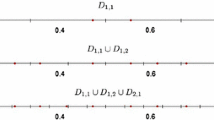Abstract
Sliced Latin hypercube designs (SLHDs) are widely used in various computer experiments. Literatures concerning the construction of SLHDs are all about constructing SLHDs with slices of the same size. However, in some cases, e.g. when an experiment with multiple computer models having different complexities or a sequential experiment with varying costs in different periods is considered, SLHDs with slices of different sizes are preferable. In this paper, we propose a new class of SLHD, named the flexible SLHD, in which the whole design is a Latin hypercube design (LHD), and each slice is also an LHD when its levels being properly collapsed, the difference lies in that its slices may have different run sizes. Several methods for constructing such designs are developed. Theoretical results on the constructed designs are derived, and discussion on the slice sizes of the constructed flexible SLHDs is provided. Furthermore, an optimization algorithm is developed to improve the space-filling property of the constructed SLHDs. The newly proposed flexible SLHD is also a special nested LHD (Qian in Biometrika 96:957–970, 2009), each of its slice can be viewed as a small LHD nested in the whole design.






Similar content being viewed by others
References
Ba S, Myers WR, Brenneman WA (2015) Optimal sliced Latin hypercube designs. Technometrics 57:479–487
Bingham D, Sitter RR, Tang B (2009) Orthogonal and nearly orthogonal designs for computer experiments. Biometrika 96:51–65
Cao RY, Liu MQ (2015) Construction of second-order orthogonal sliced Latin hypercube designs. J Complex 31:762–772
Dueck G, Scheuer T (1990) Threshold accepting: a general purpose optimization algorithm superior to simulated annealing. J Comput Phys 90:161–175
Fang KT, Liu MQ, Qin H, Zhou YD (2018) Theory and application of uniform experimental designs. Springer and Science Press, Singapore
Hickernell FJ (1998a) A generalized discrepancy and quadrature error bound. Math Comput 67:299–322
Hickernell FJ (1998b) Lattice rules: how well do they measure up? In: Hellekalek P, Larcher G (eds) Random and quasi-random point sets. Springer, New York, pp 106–166
Huang HZ, Yang JF, Liu MQ (2014) Construction of sliced (nearly) orthogonal Latin hypercube designs. J Complex 30:355–365
Johnson ME, Moore LM, Ylvisaker D (1990) Minimax and maximin distance designs. J Stat Plan Inference 26:131–148
Kong X, Ai M, Tsui KL (2018) Flexible sliced designs for computer experiments. Ann Inst Stat Math 70:631–646
McKay MD, Beckman RJ, Conover WJ (1979) Comparison of three methods for selecting values of input variables in the analysis of output from a computer code. Technometrics 21:239–245
Qian PZG (2009) Nested Latin hypercube designs. Biometrika 96:957–970
Qian PZG (2012) Sliced Latin hypercube designs. J Am Stat Assoc 107:393–399
Steinberg DM, Lin DKJ (2006) A construction method for orthogonal Latin hypercube designs. Biometrika 93:279–288
Sun FS, Liu MQ, Lin DKJ (2009) Construction of orthogonal Latin hypercube designs. Biometrika 96:971–974
Sun FS, Liu MQ, Lin DKJ (2010) Construction of orthogonal Latin hypercube designs with flexible run sizes. J Stat Plan Inference 140:3236–3242
Sun FS, Pang F, Liu MQ (2011) Construction of column-orthogonal designs for computer experiments. Sci China Math 54:2683–2692
Sun FS, Liu MQ, Qian PZG (2014) On the construction of nested space-filling designs. Ann Stat 42:1394–1425
Wang XL, Zhao YN, Yang JF, Liu MQ (2017) Construction of (nearly) orthogonal sliced Latin hypercube designs. Stat Probab Lett 125:174–180
Xie HZ, Xiong SF, Qian PZG, Wu CFJ (2014) General sliced Latin hypercube designs. Stat Sin 24:1239–1256
Yang JY, Liu MQ (2012) Construction of orthogonal and nearly orthogonal Latin hypercube designs from orthogonal designs. Stat Sin 22:433–442
Yang JF, Lin CD, Qian PZG, Lin DKJ (2013) Construction of sliced orthogonal Latin hypercube designs. Stat Sin 23:1117–1130
Yang JY, Liu MQ, Lin DKJ (2014) Construction of nested orthogonal Latin hypercube designs. Stat Sin 24:211–219
Yang JY, Chen H, Lin DKJ, Liu MQ (2016) Construction of sliced maximin-orthogonal Latin hypercube designs. Stat Sin 26:589–603
Yang X, Yang JF, Lin DKJ, Liu MQ (2016) A new class of nested orthogonal Latin hypercube designs. Stat Sin 26:1249–1267
Ye KQ (1998) Orthogonal column Latin hypercubes and their application in computer experiments. J Am Stat Assoc 93:1430–1439
Acknowledgements
The authors thank Editor Professor Werner G. M\(\ddot{\mathrm{u}}\)ller and two referees for their valuable comments. This work was supported by the National Natural Science Foundation of China (Grant Nos. 11771220, 11431006, and 11501305), National Ten Thousand Talents Program, Tianjin Development Program for Innovation and Entrepreneurship, Tianjin “131” Talents Program, Project 61331903, and Sichuan University Post-Doctor Research Project. The first two authors contribute equally to this work.
Author information
Authors and Affiliations
Corresponding author
Additional information
Publisher's Note
Springer Nature remains neutral with regard to jurisdictional claims in published maps and institutional affiliations.
Appendix: Proof of Theorem 6
Appendix: Proof of Theorem 6
-
(i)
It is known that \(N=m_1 +m_2\), and \(m_1 | N,\ m_2 | N\). So we have \(m_1 | m_2\) and \( m_2|m_1\), as all the numbers are positive integers, therefore, \(m_1=m_2=N/2\).
-
(ii)
For the positive integers \(m_1\), \(m_2\), and \(m_3\), since \(m_1 \le m_2 \le m_3\), \(N=m_1+m_2+m_3\) and \(m_i |N\) for \(i=1,2,3\), then we have
$$\begin{aligned} m_1+m_2 \le 2 m_3\ \text{ and }\ m_3 | (m_1+m_2), \end{aligned}$$which imply
$$\begin{aligned}&\displaystyle m_1+m_2 = 2 m_3, \text{ or } \end{aligned}$$(7)$$\begin{aligned}&\displaystyle m_1+m_2 = m_3. \end{aligned}$$(8)From Eq. (7), it is easy to deduce that \(m_1=m_2=m_3\). From Eq. (8) and \(m_2|N\), we have \(m_2 | 2(m_1+m_2)\), which implies \(m_2 | 2 m_1\); since \(m_1 \le m_2\), \(m_1\) and \(m_2\) have the following relation,
$$\begin{aligned}&\displaystyle 2 m_1=m_2, \text{ or } \end{aligned}$$(9)$$\begin{aligned}&\displaystyle 2 m_1=2 m_2. \end{aligned}$$(10)If Eq. (9) holds, it is easy to deduce that \(m_2=2 m_1\), \(m_3=3 m_1\), and \(m_1<m_2<m_3\). Alternatively, if Eq. (10) holds, it is easy to deduce that \(m_3=2 m_1\) and \(m_1=m_2<m_3\). This completes the proof. \(\square \)
Rights and permissions
About this article
Cite this article
Yuan, R., Guo, B. & Liu, MQ. Flexible sliced Latin hypercube designs with slices of different sizes. Stat Papers 62, 1117–1134 (2021). https://doi.org/10.1007/s00362-019-01127-6
Received:
Revised:
Published:
Issue Date:
DOI: https://doi.org/10.1007/s00362-019-01127-6




